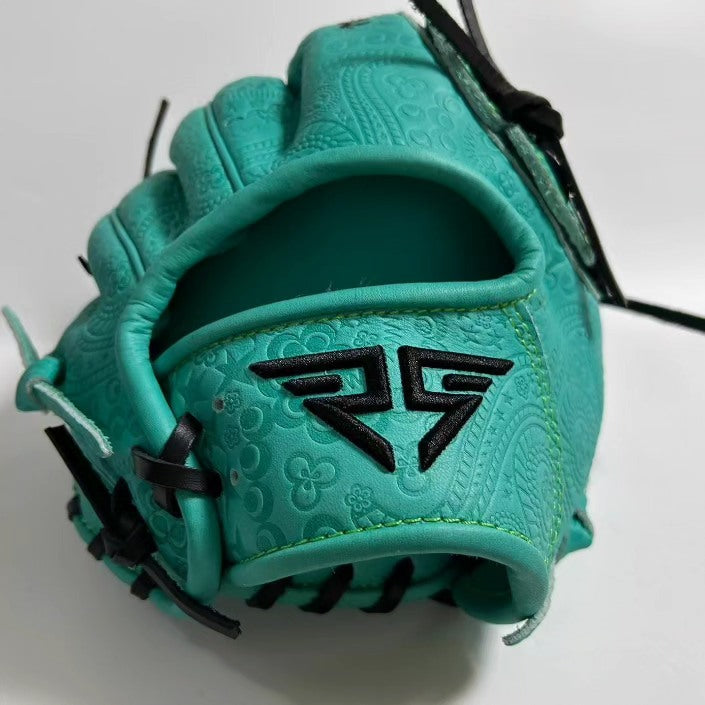When it comes to picking the right baseball glove, there's a lot more to it than grabbing the first one off the rack. Gloves should feel like an extension of your hand, ready to scoop, snag, and stick when the moment counts.
Here’s a rundown on what goes into selecting a glove, starting with how to measure it right, and moving into the details that matter when finding the perfect fit Like the leather, the break-in time, and how it’s going to feel in the 9th inning.
A good glove isn’t an "accessory"—it’s a tool of the trade, and picking the right one can be the difference between making the play, or watching it roll by.
Measuring For a Baseball Glove
How Do I Know What Size Baseball Glove I Need?
Both off-the-shelf and custom baseball gloves are typically measured in inches, starting from the top of the index finger, down through the palm, to the heel of the glove. Most fielding gloves range from 9 to 12.5 inches for youth players and 10.5 to 12.75 inches for adults. The size needed largely depends on the age and the position of the player.
For catchers, the mitts differ as they are measured by their circumference to better accommodate the wider surface area needed for catching pitches. Catcher's mitt sizes usually range from 32.5 to 34 inches for adults. This is a good size to make sure that the glove can adequately cover the necessary space while maintaining a certain amount of maneuverability.
Now, let’s be real for a second—finding the right size glove can seem like an overwhelming process if you’re just starting out. You’ve got to consider not only hand size and age but also what position you’re playing. For example, infielders need a smaller, more compact glove that allows for quick transfers, while outfielders typically go for larger gloves to help with those diving catches. It’s no wonder that MLB pros are known to take their time selecting their personal gear, because when it comes to finding the best baseball gloves, a "custom fit" really makes a difference.
It's kind of like picking out a good pair of sneakers—some people prefer breaking them in, knowing they'll last a while, others want something comfortable from the start. That all comes down to personal preference, but the key is understanding what you're getting for your money. The best batting gloves and mitts aren’t always the most expensive ones but rather the ones that fit your needs just right.
To make it easier, here’s a handy size chart to help you figure out glove sizing based on position and player age. It’ll take a lot of the guesswork out of the process and help you get your hands on a glove (or preferably in one) that feels like it was custom-made for you personally.
Baseball Glove Size Chart
Determining Your Glove Size
Selecting the right baseball glove involves considering key factors such as your hand size, age, and field position. The size charts provided below are a reference to help determine the appropriate glove size for your needs:
Note: These sizes provide general guidelines only. Always consider how the glove actually feels and fits when it's on the hand.
Youth Sizes (Ages 4 to 12)
- T-Ball - 8.5 - 10 inches
- Infield - 9 - 11 inches
- Outfield - 10 - 12 inches
- Catcher's Mitt - 29.5 - 30 inches
- First Base Mitt - 11.5 - 12 inches
- Pitcher - 10 - 11.5 inches
Adult & Teenage Sizes (Ages 13 and up)
- Infield - 11 - 11.75 inches
- Outfield - 12 - 12.75 inches
- Catcher's Mitt - 32.5 - 34 inches
- First Base Mitt - 12 - 13 inches
- Pitcher - 11.5 - 12 inches
See:How to Measure Your Hand for a Baseball Glove
Baseball Glove Sizing by Position
Infield Gloves
If you're an infielder… think fast! Your glove should be small—around 11 to 11.5 inches. You want speed, allowing you to grab that ball and throw it fast.
The pocket should be shallow, making it easy to pull the ball out and whip it to first base for the out. Choose a glove that balances stiffness for durability and softness for quick action. Breaking it in well is key so it moves with your hand as if it's just another part of you.
Outfield Gloves
Playing in the outfield? You need a glove that can go the distance. Something larger, between 12.5 to 13 inches, with a deep pocket to handle those high-flying catches. This type of glove helps cushion the impact when you snag a ball out of the sky and keeps it secure as you prepare to throw.
First Base Mitts
First base mitts are the tanks of baseball gloves. They're bigger and tougher, designed to catch everything thrown your way—literally. With a mix between an infield glove and a catcher's mitt, these are about 12 to 13 inches and have an open web to help you scoop up those grounders and grab throws from your teammates.
Pitching Gloves
Pitchers need stealth on their side. Your glove should be close to an infield size but with a closed web to keep the ball and your grip hidden from the batter. (This will help keep your pitches a surprise until they're on their way.)
As far as measuring/fitting goes, the glove should feel like part of your arm, comfortable enough to keep your focus sharp inning after inning.
Catcher’s Mitts
Catchers, you're in the hot seat. Your mitt needs to be solid, with extra padding to handle those fast pitches. Sizing is fairly important here—something between 32.5 to 34 inches will give you the surface area to catch whatever comes your way and the snug fit needed for quick throws to keep runners in check.
Batting Gloves
Though not meant for catching, batting gloves are important for handling the bat. They protect your hands from blisters and improve your grip, making sure the bat feels right during swings.
Factors to Consider When Choosing Gloves
-
Position-Specific Designs - Gloves aren't all made the same. Every spot on the field’s got its own kind, designed to handle the job at hand—no pun intended:
- Pitchers - Prefer gloves with closed webs to hide the ball and grip changes from batters.
- Catchers - Use mitts that are robust and heavily padded to endure repeated high-velocity catches.
- Infielders - Opt for smaller, more nimble gloves with shallow pockets for quick ball retrieval and release.
- Outfielders - Choose larger gloves with deeper pockets to assist in catching fly balls.
-
Material Quality - Baseball gloves are typically made from various types of leather:
- Synthetic Leather - Lightweight and easier to break in, ideal for younger players.
- Full-Grain Leather - Durable and firm, these gloves take longer to break in but offer superior longevity and performance.
- Japanese Kip Gloves -Known for its high-quality and soft feel, this leather offers excellent balance between durability and flexibility, and it also breaks in quicker than full-grain leather while still maintaining high performance.
- Treated Leather - Offers a softer feel from the start and requires less break-in time.
-
Webbing Types - The webbing connects the thumb and fingers to provide structure and control. Each glove pattern has its place in the game, whether it's scooping up grounders, catching high flies, or keeping your next pitch a mystery. Which baseball glove webbing you pick should be based on your position and playing style to really own your spot on the field.
- Open webs - Offer better visibility and are generally preferred by infielders and outfielders for tracking high flies.
- Closed webs - Provide more support and are favored by pitchers for concealing the ball.
-
Wrist Adjustments - Adjustable wrist closures can help secure the glove to your hand:
- Velcro Straps - Allow for quick and easy adjustments.
- D-Ring Fasteners - Offer more precise fit adjustments.
- Conventional Openings - Provide a looser fit for quicker hand removal.
- Budget and Brand Considerations - The cost of baseball gloves can vary significantly, influenced by brand, leather material, and craftsmanship. Gloves from brands like Wilson, Rawlings, and Mizuno may come with a hefty price tag, but for young athletes and adult recreational play, there are plenty of high-quality options that won’t break the bank.
You don’t want to be caught flat-footed with a poor-quality, loose-fitting, or just plain bad glove when a hard-hit grounder's coming your way. Get one that measures up just for you—and you’ll be calling the shots every time the ball’s in play.
Custom Gloves by Relentless Sports
Ready to elevate your game with custom gear? At Relentless, our personalized baseball gloves are hand-crafted from premium cowhide or Japanese kip leather, giving you long-lasting durability and a premium feel tailored to your play style. Whether you're a youth player or competing at the pro level, you can design your perfect glove with our easy-to-use 3D builder.
Looking to complete your setup? Our customizable batting gloves offer pro-level quality and full personalization options. Choose your team colors, add your logo, name, and number, and select from two palm choices to create batting gloves that match your style and performance needs.
Your game deserves the best—so start building your custom baseball gear now!

